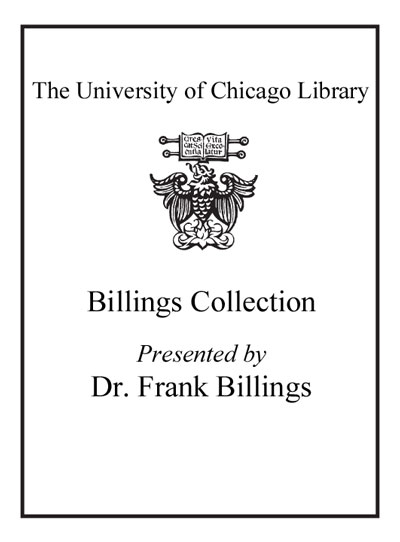Bioinformatics basics : applications in biological science and medicine /
Saved in:
| Edition: | 2nd ed. |
|---|---|
| Imprint: | Boca Raton : Taylor & Francis, 2005. |
| Description: | 335 p. : ill. ; 25 cm. |
| Language: | English |
| Subject: | |
| Format: | Print Book |
| URL for this record: | http://pi.lib.uchicago.edu/1001/cat/bib/5727008 |
Table of Contents:
- 1. Biology and Information
- 1.1. Bioinformatics-A Rapidly Maturing Science
- 1.1.1. From Genes to Proteins
- 1.1.2. Bioinformatics in the Public Domain
- 1.2. Computers in Biology and Medicine
- 1.2.1. Computational Tools
- 1.2.2. Limitations of Computational Tools
- References
- 1.3. The Virtual Doctor
- 1.3.1. Mapping the Human Brain
- References
- 1.4. Biological Macromolecules as Information Carriers
- References
- 1.5. Proteins: From Sequence to Structure to Function
- 1.5.1. Molecular Interaction in Protein Structures
- 1.5.1.1. The Peptide Bond
- 1.5.1.2. Characteristics of the Peptide Bond
- 1.5.1.3. The Hydrophobic Effect and How It Contributes to Protein Folding
- 1.5.1.4. Electrostatic Interactions
- 1.5.1.5. Hydrogen Bonding
- 1.5.1.6. Conformational Entropy
- 1.5.1.7. Van der Waals Interactions (Packing)
- 1.5.1.8. Covalent Bonds (e.g., Disulfide Bridge)
- 1.5.2. Protein Functions
- 1.5.2.1. Enzymes
- 1.5.2.2. Regulatory Proteins
- 1.5.2.3. Storage
- 1.5.2.4. Transportation
- 1.5.2.5. Signaling
- 1.5.2.6. Immunity
- 1.5.2.7. Structural
- References
- 1.6. DNA and RNA Structure
- 1.6.1. The DNA Double Helix
- 1.6.2. Genomic Size of DNA
- References
- 1.7. DNA Cloning and Sequencing
- 1.7.1. DNA Cloning
- 1.7.2. Transcriptional Profiling
- 1.7.3. Positional Cloning and Chromosome Mapping
- 1.7.4. Polymerase Chain Reaction (PCR)
- 1.7.5. Sequencing Technologies
- References
- 1.8. Genes, Taxonomy, and Evolution
- References
- 2. Biological Databases
- 2.1. Biological Database Organization
- 2.1.1. Database Content and Management
- 2.1.2. Data Submissions
- 2.1.3. The Growth of Public Databases
- 2.1.4. Data Retrieval
- References
- 2.1.5. Data Annotation and Database Connectivity
- 2.1.5.1. Annotation
- 2.1.5.2. Redundancy
- 2.2. Public Databases
- 2.2.1. National Center for Biotechnology Information (NCBI)
- 2.2.1.1. Who is Employed by NCBI?
- 2.2.1.2. What Kind of Research is Conducted at NCBI?
- 2.2.1.3. What Types of Databases are Supported by NCBI?
- 2.2.1.4. What Do We Mean by Redundancy?
- 2.2.1.5. What are Some of the Services Offered by NCBI?
- References
- 2.2.2. European Bioinformatics Institute (EBI)
- 2.2.2.1. Who is Employed by EBI?
- 2.2.2.2. What Kind of Research is Conducted at EBI?
- 2.2.2.3. What Are Some Of The Services Offered By EBI?
- References
- 2.2.3. Kyoto Encyclopedia of Genes and Genomes (KEGG)
- 2.2.3.1. Classification of Biological Molecules
- 2.2.3.2. Cellular Processes at KEGG
- References
- 2.3. Database Mining Tools
- 2.3.1. Sequence Similarity Search Tools: BLAST and FASTA
- 2.3.1.1. Shared Characteristics in Both Sequence Alignment Tools
- 2.3.1.2. How are Sequence Alignments Useful?
- 2.3.1.3. Basic Local Alignment Search Tool (BLAST)
- 2.3.2. An Overview of Database Sequence Searching
- References
- 2.3.3. Pattern Recognition Tools (Prosite)
- 2.3.3.1. The Significance of Embedded Symbols within Each Signature and How to Read and Construct Signatures
- References
- 2.3.4. Multiple Alignment and Phylogenetic Tree Analysis
- References
- 3. Genome Analysis
- 3.1. The Genomic Organization of Genes
- 3.1.1. What are Genomes?
- 3.1.2. Mapping and Navigating Genomes
- 3.1.2.1. Genetic Linkage Maps
- 3.1.2.2. Physical Maps
- 3.1.2.3. From Sequence Maps to Gene Function Maps
- References
- 3.1.2. The Genome Projects
- 3.1.2.1. How Many Genes are in a Genome?
- References
- 3.1.3. The Human Genome
- References
- 3.2. Comparative Genomics
- 3.2.1. Cluster of Orthologous Groups (COGs)
- 3.2.2. Homologene at NCBI
- References
- 3.2.2.1. Gene Order and Chromosome Rearrangements
- 3.2.2.2. MapViewer
- References
- 3.3. Functional Genomics
- 3.3.1. The Transcriptome
- 3.4. Microarray and Bioarray Technology
- 3.4.1. Concept and Use
- 3.4.2. Summary of a Typical Experiment Using Microarray Technology
- 3.4.3. Microarray Bioinformatics
- 3.4.4. Image Processing
- References
- 3.4.5. Data Annotation
- References
- 3.4.6. Data Analysis
- 3.4.6.1. Experiment Design/Plan
- 3.4.6.2. Volume of Data
- 3.4.6.3. Dimensionality of Data
- 3.4.6.4. Quality of Data
- 3.4.7. Normalization
- 3.4.8. Statistical Analysis
- 3.4.9. Explorative Analysis
- 3.4.9.1. Aim of Clustering
- 3.4.9.2. Biological Interpretation of Clustering Results
- 3.4.9.3. Theory of Clustering
- 3.4.9.4. Clustering vs. Classification (Unsupervised vs. Supervised)
- 3.4.10. Main Types of Clustering
- 3.4.10.1. Hierarchical Clustering
- 3.4.10.2. Nonhierarchical Clustering
- 3.4.10.3. Other Clustering or Classification Algorithms
- 3.4.10.4. Advice on Using Clustering
- References
- 3.4.11. Data Storage
- References
- 3.4.12. Data Mining
- 3.4.13. Protein Arrays
- 3.4.14. Concluding Remarks
- 3.5. Genomes as Gene Networks
- References
- 4. Proteome Analysis
- 4.1. Proteomics
- 4.1.1. What is a Proteome?
- 4.1.1.1. 2-D Gels and Mass Spectrometry Tools
- 4.1.1.2. 2-D PAGE at Expasy (Swiss Bioinformatics Institute)
- References
- 4.2. Hydrodynamic Methods
- 4.2.1. Introduction
- 4.2.2. Analytical Ultracentrifugation
- 4.2.2.1. Experimental Setup and Instrumentation
- 4.2.2.2. Transport Processes in The AUC Cell
- 4.2.2.3. Analytical Ultracentrifuge (AUC) Experiments
- 4.2.3. Light Scattering
- 4.2.3.1. Experimental Setup and Instrumentation
- 4.2.3.2. Dynamic Light Scattering
- 4.2.3.3. Static Light Scattering
- 4.2.4. Global Analysis
- 4.2.5. Appendix
- References
- 4.3. Predictive Biology
- 4.3.1. Protein Structure Prediction
- 4.3.1.1. Structure Prediction Software
- References
- 4.3.2. Structural Genomics
- References
- 4.3.3. Rational Drug Design
- References
- 4.4. Systems Biology
- 4.4.1. Protein Interaction Networks
- References
- 4.4.2. Metabolic Reconstruction
- References
- 5. The Bioinformatics Revolution in Medicine
- 5.1. Genes and Diseases
- 5.1.1. From Molecules to Diseases
- References
- 5.1.2. Online Mendelian Inheritance in Man (OMIM)
- References
- 5.1.3. Pharmacogenomics
- 5.2. Agricultural Genomics
- 5.2.1. Genetically Modified Organisms
- References
- 5.2.2. Biopharming
- References
- Appendix A. Glossary of Biological Terms
- Appendix B. Bioinformatics Web Sites
- Index


